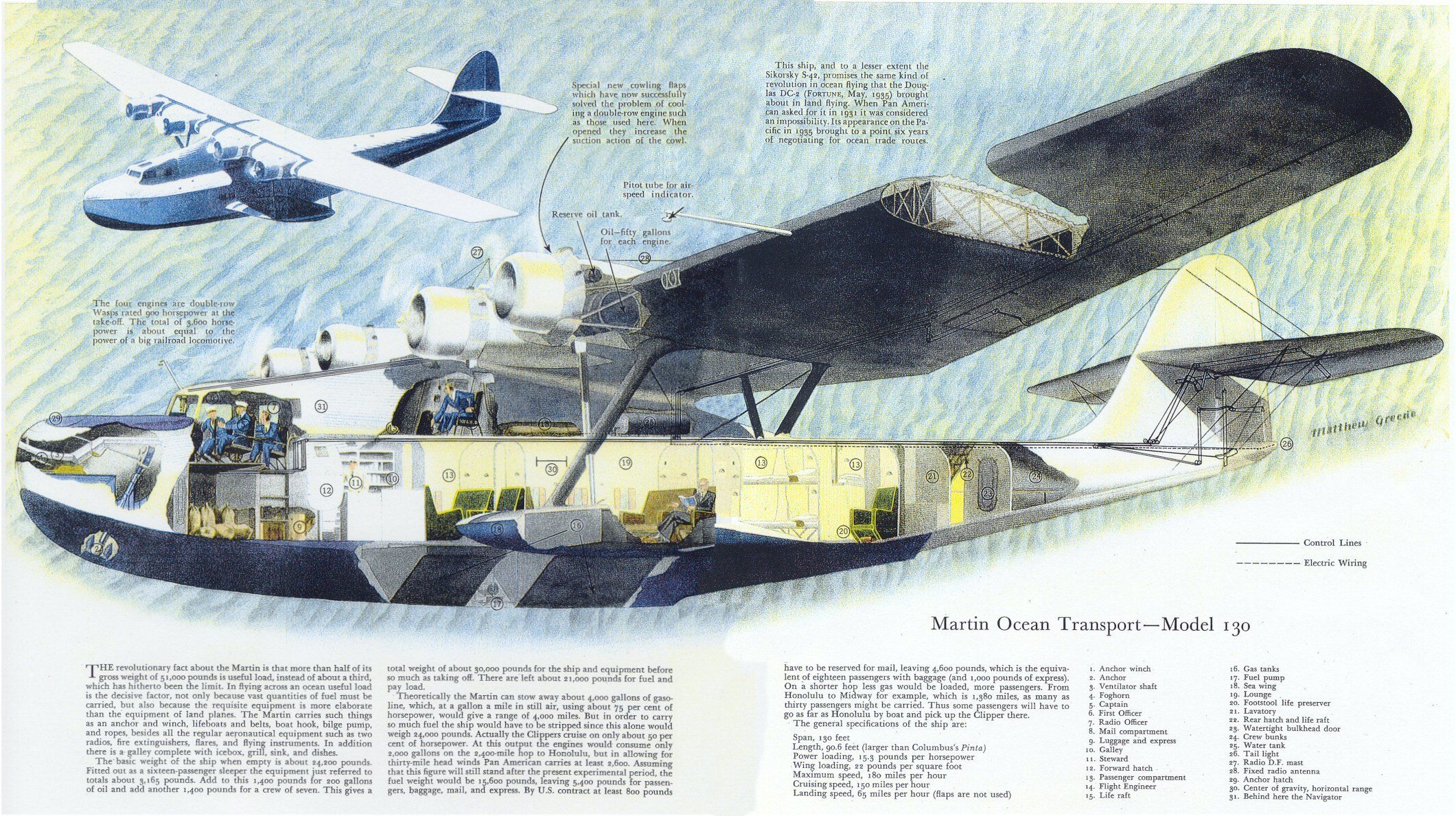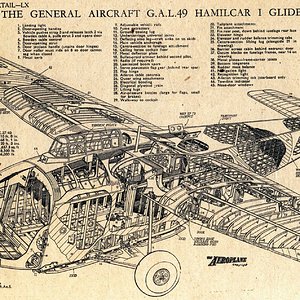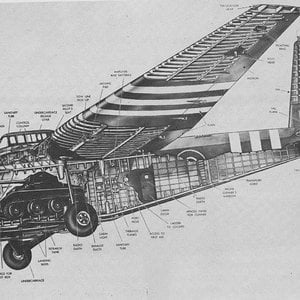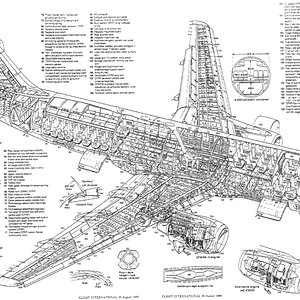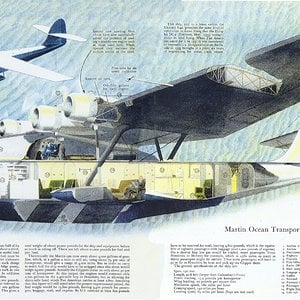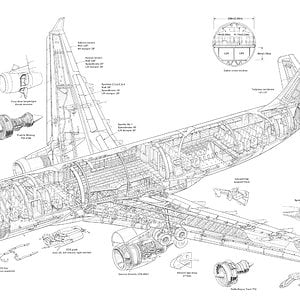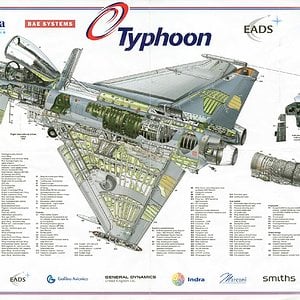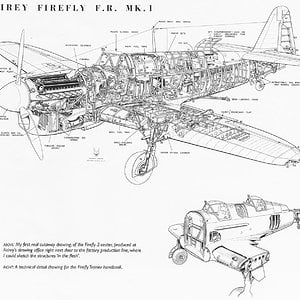Navigation
Install the app
How to install the app on iOS
Follow along with the video below to see how to install our site as a web app on your home screen.
Note: This feature may not be available in some browsers.
More options
You are using an out of date browser. It may not display this or other websites correctly.
You should upgrade or use an alternative browser.
You should upgrade or use an alternative browser.
The revolutionary fact about the Martin is that more than half of its gross weight of 51,000 pounds is useful load, instead of about a third, which has hitherto been the limit. In flying across an ocean useful load is the decisive factor, not only because vast quantities of fuel must be carried, but also because the requisite equipment is more elaborate than the equipment of land planes. The Martin carries such things as an anchor and winch, lifeboat and belts, boat hook, bilge pump, and ropes, besides all the regular aeronautical equipment such as two radios, fire extinguishers, flares, and flying instruments. In addition there is a galley complete with icebox, grill, sink, and dishes.
Prototype Boeing 314 Flying Boat in Lake Washington, WA in 1938 -- prior to becoming the "Honolulu Clipper"
Boeing 314 Clipper history. Wow. I've tried to be accurate, but offer the caveat that there exists a lot of conflicting information on this subject ....
This same Boeing 314 flying boat (seen here in 1938 in Washington State's * Lake Washington) today lies in 18,000 feet of ocean. Built for Pan American Airways, the huge flying boat was assembled at Boeing's Plant 1 on the Duwamish River.The first flight was on June 7, 1938. NC18601 - began life as NX18601 - the first of 12 produced, 1938 to 1941. Although Boeing didn't call that, it was in reality the prototype. In January 1939, now as the Honolulu Clipper, she began flying the San Francisco-Hong Kong route - a six-hour flight.
Pan Am's "Clippers" were built for "one-class" luxury air travel; The seats converted into 36 bunks, it had a lounge and dining area, and the galleys were crewed by chefs from four-star hotels. White-coated stewards served five and six-course meals with gleaming silver service. The standard of luxury on Pan American's Boeing 314s has rarely been matched on heavier-than-air transport since then; they were a form of travel for the super-rich.
On November 3, 1945, the "Honolulu Clipper" was flying military passengers and mail across the south Pacific Ocean from Hawaii to San Francisco. At about 650 miles from Hawaii her 2 starboard engines caught fire, then quit. They threw-out mail and everything else they could; yet the aircraft continued losing altitude, forcing a landing in the Pacific Ocean. There were no injuries, no damage to the plane; everyone was rescued just four hours later. Yet fate has been fatal to Clippers putting-down in the open ocean.
Over a number of days, a troop transport ship and later a seaplane tender tried to tow the Clipper. Mechanics boarded the 314, but were unable to make repairs. In high seas, the Clipper "rammed into the tender". A starboard wing tip broke off, and an engine snapped off and tore through the Clipper's bow. Over 11 days, the flying boat drifted within 450 miles of Hawaii. Navy brass now deemed it "a hazard to navigation". That is upsetting....
I realize I'm 'second-guessing' the attitude of the era... I'm looking at it today, when none survive intact. Yet in 1945 she was only one of two still flying. Long-range airliners like the Constellation and the DC-4, the changing land-based airport availability (etc.) had put the other Clippers in-line for scrapping; the two 'survivors' would have likely had the same fate. Seems incredible, but there was little interest in preserving even one of them. The Navy issued orders to sink her. After having flown 18,000 hours and countless passengers, and opening new possibilities in the world of aviation, the Clipper sank beneath the waves on November 14 -- after being fired upon with over 1,200 20-mm explosive shells....
The other Clipper, the Bermuda Sky Queen, was sunk in a nearly identical fashion 2 years later, in the Atlantic. But that's another story...
When I was between 4 and 5 years old, at least 7 of the Boeing 314's were stored just 15 minutes from our home, at downtown San Diego's Lindbergh Field; from there, they were scrapped.
Engines: Four (4) 1,600 hp (1,192 kW) Wright R-2600 Twin Cyclone (1,192 kw), 14 cylinder, air-cooled, radial engines -- Wing Span: 152 ft. (46.33 m.) -- Length: 106 ft (32.31 m.) -- Max T.O. Weight: 84,000 lb. (38,102 kg.) -- Max level speed: 199 mph (320 km/h) -- Cruising speed: 184 mph (296 km/h) -- Range: 5,200 miles (8369 km) -- First flight: June 7, 1938 -- Ceiling: 19,600 feet -- Accommodation: 10 crew, 74 passengers
Variants:
Model 314 Initial production version with 1,500 horsepower (1,100 kW) Twin Cyclone engines, six built
Model 314A Improved version with 1,600 horsepower (1,200 kW) Twin Cyclones with larger-diameter propellers, additional 1,200 US gallons (4,500 l; 1,000 imp gal) fuel capacity, and revised interior. Still air range approx 4,700 miles[16] six built
Military service of the 12 aircraft:
B-314 Five Model 314s impressed into military service with the U.S. Navy
C-98 Four Model 314s impressed into military service with the U.S. Army Air Forces
Today, a group wants to retrieve this Clipper -- 530 miles northeast of Hawaii -- along with the Bermuda Sky Queen, submerged in the North Atlantic. Underwater Admiralty Sciences (UAS) hopes to find someone to underwrite the estimated $8 million or more needed.
Good luck to them.
* Lake Washington itself is home to many aviation wrecks
Only two structures remain from the original Boeing Plant 1 site. Building 105, "the Red Barn", is at the Museum of Flight; the other is the 1929-vintage administration building, in its original location, just south of the Terminal 115 site at 200 Southwest Michigan Street, Seattle.
Prototype Boeing 314 Flying Boat in Lake Washington, WA in 1938 -- prior to becoming the "Honolulu Clipper"
Boeing 314 Clipper history. Wow. I've tried to be accurate, but offer the caveat that there exists a lot of conflicting information on this subject ....
This same Boeing 314 flying boat (seen here in 1938 in Washington State's * Lake Washington) today lies in 18,000 feet of ocean. Built for Pan American Airways, the huge flying boat was assembled at Boeing's Plant 1 on the Duwamish River.The first flight was on June 7, 1938. NC18601 - began life as NX18601 - the first of 12 produced, 1938 to 1941. Although Boeing didn't call that, it was in reality the prototype. In January 1939, now as the Honolulu Clipper, she began flying the San Francisco-Hong Kong route - a six-hour flight.
Pan Am's "Clippers" were built for "one-class" luxury air travel; The seats converted into 36 bunks, it had a lounge and dining area, and the galleys were crewed by chefs from four-star hotels. White-coated stewards served five and six-course meals with gleaming silver service. The standard of luxury on Pan American's Boeing 314s has rarely been matched on heavier-than-air transport since then; they were a form of travel for the super-rich.
On November 3, 1945, the "Honolulu Clipper" was flying military passengers and mail across the south Pacific Ocean from Hawaii to San Francisco. At about 650 miles from Hawaii her 2 starboard engines caught fire, then quit. They threw-out mail and everything else they could; yet the aircraft continued losing altitude, forcing a landing in the Pacific Ocean. There were no injuries, no damage to the plane; everyone was rescued just four hours later. Yet fate has been fatal to Clippers putting-down in the open ocean.
Over a number of days, a troop transport ship and later a seaplane tender tried to tow the Clipper. Mechanics boarded the 314, but were unable to make repairs. In high seas, the Clipper "rammed into the tender". A starboard wing tip broke off, and an engine snapped off and tore through the Clipper's bow. Over 11 days, the flying boat drifted within 450 miles of Hawaii. Navy brass now deemed it "a hazard to navigation". That is upsetting....
I realize I'm 'second-guessing' the attitude of the era... I'm looking at it today, when none survive intact. Yet in 1945 she was only one of two still flying. Long-range airliners like the Constellation and the DC-4, the changing land-based airport availability (etc.) had put the other Clippers in-line for scrapping; the two 'survivors' would have likely had the same fate. Seems incredible, but there was little interest in preserving even one of them. The Navy issued orders to sink her. After having flown 18,000 hours and countless passengers, and opening new possibilities in the world of aviation, the Clipper sank beneath the waves on November 14 -- after being fired upon with over 1,200 20-mm explosive shells....
The other Clipper, the Bermuda Sky Queen, was sunk in a nearly identical fashion 2 years later, in the Atlantic. But that's another story...
When I was between 4 and 5 years old, at least 7 of the Boeing 314's were stored just 15 minutes from our home, at downtown San Diego's Lindbergh Field; from there, they were scrapped.
Engines: Four (4) 1,600 hp (1,192 kW) Wright R-2600 Twin Cyclone (1,192 kw), 14 cylinder, air-cooled, radial engines -- Wing Span: 152 ft. (46.33 m.) -- Length: 106 ft (32.31 m.) -- Max T.O. Weight: 84,000 lb. (38,102 kg.) -- Max level speed: 199 mph (320 km/h) -- Cruising speed: 184 mph (296 km/h) -- Range: 5,200 miles (8369 km) -- First flight: June 7, 1938 -- Ceiling: 19,600 feet -- Accommodation: 10 crew, 74 passengers
Variants:
Model 314 Initial production version with 1,500 horsepower (1,100 kW) Twin Cyclone engines, six built
Model 314A Improved version with 1,600 horsepower (1,200 kW) Twin Cyclones with larger-diameter propellers, additional 1,200 US gallons (4,500 l; 1,000 imp gal) fuel capacity, and revised interior. Still air range approx 4,700 miles[16] six built
Military service of the 12 aircraft:
B-314 Five Model 314s impressed into military service with the U.S. Navy
C-98 Four Model 314s impressed into military service with the U.S. Army Air Forces
Today, a group wants to retrieve this Clipper -- 530 miles northeast of Hawaii -- along with the Bermuda Sky Queen, submerged in the North Atlantic. Underwater Admiralty Sciences (UAS) hopes to find someone to underwrite the estimated $8 million or more needed.
Good luck to them.
* Lake Washington itself is home to many aviation wrecks
Only two structures remain from the original Boeing Plant 1 site. Building 105, "the Red Barn", is at the Museum of Flight; the other is the 1929-vintage administration building, in its original location, just south of the Terminal 115 site at 200 Southwest Michigan Street, Seattle.

